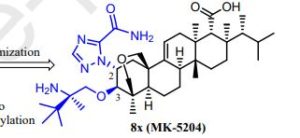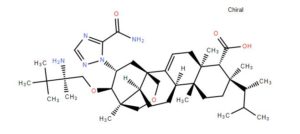
MK 5204
| CAS No: | 1207751-75-4 |
| Product Code: | BM178545 |
(1R,5S,6R,7R,10R,11R,14R,15S,20R,21R)-21-[(2R)-2-amino-2,3,3-trimethylbutoxy]-20-(5-carbamoyl-1,2,4-triazol-1-yl)-5,7,10,15-tetramethyl-7-[(2R)-3-methylbutan-2-yl]-17-oxapentacyclo[13.3.3.01,14.02,11.05,10]henicos-2-ene-6-carboxylic acid
MW 695.97
C40 H65 N5 O5

PAPER
https://www.sciencedirect.com/science/article/abs/pii/S0960894X20304686

Abstract
Our previously reported efforts to produce an orally active β-1,3-glucan synthesis inhibitor through the semi-synthetic modification of enfumafungin focused on replacing the C2 acetoxy moiety with an aminotetrazole and the C3 glycoside with a N,N-dimethylaminoether moiety. This work details further optimization of the C2 heterocyclic substituent, which identified 3-carboxamide-1,2,4-triazole as a replacement for the aminotetrazole with comparable antifungal activity. Alkylation of either the carboxamidetriazole at C2 or the aminoether at C3 failed to significantly improve oral efficacy. However, replacement of the isopropyl alpha amino substituent with a t-butyl, improved oral exposure while maintaining antifungal activity. These two structural modifications produced MK-5204, which demonstrated broad spectrum activity against Candida species and robust oral efficacy in a murine model of disseminated Candidiasis without the N-dealkylation liability observed for the previous lead.

patent
https://patentscope.wipo.int/search/en/detail.jsf?docId=US43243783&tab=PCTDESCRIPTION&_cid=P22-KD34BU-17225-1
| Patent ID | Title | Submitted Date | Granted Date |
|---|---|---|---|
| US8188085 | Antifungal agents | 2010-05-06 | 2012-05-29 |
|
ungal infection is a major healthcare problem, and the incidence of hospital-acquired fungal diseases continues to rise. Severe systemic fungal infection in hospitals (such as candidiasis, aspergillosis, histoplasmosis, blastomycosis and coccidioidomycosis) is commonly seen in neutropaenic patients following chemotherapy and in other oncology patients with immune suppression, in patients who are immune-compromised due to Acquired Immune Deficiency Syndrome (AIDS) caused by HIV infection, and in patients in intensive care. Systemic fungal infections cause ˜25% of infection-related deaths in leukaemics. Infections due to Candida species are the fourth most important cause of nosocomial bloodstream infection. Serious fungal infections may cause 5-10% of deaths in patients undergoing lung, pancreas or liver transplantation. Treatment failures are still very common with all systemic mycoses. Secondary resistance also arises. Thus, there remains an increasing need for effective new therapy against mycotic infections.
|
|
Enfumafungin is a hemiacetal triterpene glycoside that is produced in fermentations of a Hormonema spp. associated with living leaves of Juniperus communis (U.S. Pat. No. 5,756,472; Pelaez et al., Systematic and Applied Microbiology, 23:333-343, 2000; Schwartz et al., JACS, 122:4882-4886, 2000; Schwartz, R. E., Expert Opinion on Therapeutic Patents, 11(11):1761-1772, 2001). Enfumafungin is one of the several triterpene glycosides that have in vitro antifungal activities. The mode of the antifungal action of enfumafungin and other antifungal triterpenoid glycosides was determined to be the inhibition of fungal cell wall glucan synthesis by their specific action on (1,3)-β-D-glucan synthase (Onishi et al., Antimicrobial Agents and Chemotherapy, 44:368-377, 2000; Pelaez et al., Systematic and Applied Microbiology, 23:333-343, 2000). 1,3-β-D-Glucan synthase remains an attractive target for antifungal drug action because it is present in many pathogenic fungi which affords broad antifungal spectrum and there is no mammalian counterpart and as such, compounds inhibiting 1,3-β-D-Glucan synthase have little or no mechanism-based toxicity.
|
SIMILAR BUT NOT SAME
METHOXY EXAMPLE
Example 8
(1S,4aR,6aS,7R,8R,10aR,10bR,12aR,14R,15R)-15-[[(2R)-2-amino-2,3-dimethylbutyl]oxy]-8-[(1R)-1,2-dimethylpropyl]-14-[3-(methoxycarbonyl)-1H-1,2,4-triazol-1-yl]-1,6,6a,7,8,9,10,10a,10b,11,12,12a-dodecahydro-1,6a,8,10a-tetramethyl-4H-1,4a-propano-2H-phenanthro[1,2-c]pyran-7-carboxylic acid (EXAMPLE 8A) and (1S,4aR,6aS,7R,8R,10aR,10bR,12aR,14R,15R)-15-[[(2R)-2-amino-2,3-dimethylbutyl]oxy]-8-[(1R)-1,2-dimethylpropyl]-14-[5-(methoxycarbonyl)-1H-1,2,4-triazol-1-yl]-1,6,6a,7,8,9,10,10a,10b,11,12,12a-dodecahydro-1,6a,8,10a-tetramethyl-4H-1,4a-propano-2H-phenanthro[1,2-c]pyran-7-carboxylic acid (EXAMPLE 8B)
Example 8A
Example 8B
/////////////MK 5204, BM178545
NC(=O)c6ncnn6[C@@H]1C[C@]45COC[C@@](C)([C@H]1OC[C@](C)(N)C(C)(C)C)[C@@H]5CC[C@H]3C4=CC[C@@]2(C)[C@H](C(=O)O)[C@](C)(CC[C@@]23C)[C@H](C)C(C)C
CC(C)C(C)C1(CCC2(C3CCC4C5(COCC4(C3=CCC2(C1C(=O)O)C)CC(C5OCC(C)(C(C)(C)C)N)N6C(=NC=N6)C(=O)N)C)C)C

















![(1R,5S,6R,7R,10R,11R,14R,15S,20R,21R)-21-[(2R)-2-Amino-2,3,3-trimethylbutoxy]-20-(5-carbamoyl-1,2,4-triazol-1-yl)-5,7,10,15-tetramethyl-7-[(2R)-3-methylbutan-2-yl]-17-oxapentacyclo[13.3.3.01,14.02,11.05,10]henicos-2-ene-6-carboxylic acid.png](https://pubchem.ncbi.nlm.nih.gov/image/imgsrv.fcgi?cid=59312774&t=l)
